AMD 2014 Mobile APU Update: Beema and Mullins
by Jarred Walton on November 13, 2013 5:15 PM EST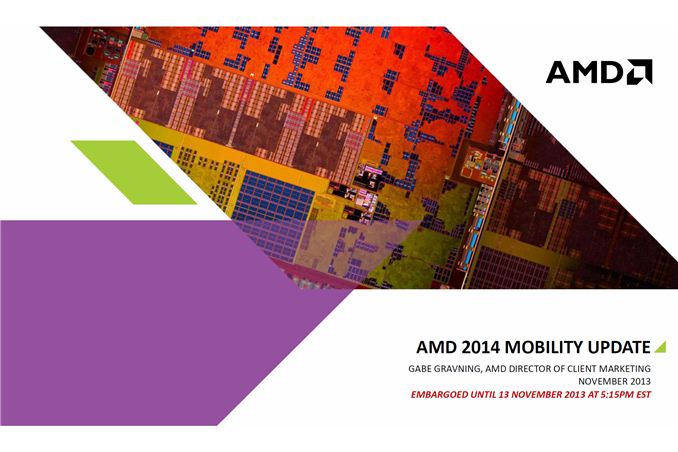
Today AMD is taking the wraps off their upcoming mobile APUs, joining the already discussed desktop Kaveri. While Kaveri will also be coming to laptops at some point in the first half of 2014, the focus during the mobile APU briefing was squarely on the replacements for the current Temash and Kabini APUs, codenamed Mullins and Beema.
We looked at Kabini earlier this year, but while sales of laptops and tablets with the Kabini/Temash APUs have reportedly been quite good, we haven’t had the chance to test any retail laptops. With Intel’s Bay Trail set to give Atom a much-needed kick in the pants as far as performance is concerned, AMD hasn’t been standing still and their next generation of “small core” APUs looks ready to give Silvermont some stiff competition. Here’s what we know right now.
First and foremost, these are actually new cores as opposed to mere tweaks of existing designs. Temash and Kabini used “Jaguar” cores, built on a 28nm process node; Mullins and Beema will also use 28nm technology, with “Puma” cores, but along with improvements to the design to reduce the power use, AMD is also incorporating an ARM Cortex-A5 core with TrustZone technology to help with security. Here’s the quick overview of the current and roadmap:
AMD hasn’t disclosed how much the underlying architecture has changed, and I would guess the Puma cores are actually quite similar to Jaguar cores, but the net result is a 2X improvement in performance per Watt according to AMD. They arrive at that number by dividing the performance in a few common benchmarks by the rated TDP of the APUs. Now that’s a bit contrived, as a 25W TDP APU may not actually be drawing 25W during the tests, but we’ll just ignore the marketing for now and focus on the important metrics. Update: It sounds like most of the performance gains come from frequency increases, while power improvements happen at the SoC level.
First, we have Beema replacing Kabini, and with the change we get the AMD Security Processor (ARM Cortex-A5) and a reduction in TDP on some parts, with 10W being the minimum. Mullins does the same for Temash, only AMD uses SDP (Scenario Design Power) rather than TDP (Thermal Design Power), and the new APUs are ~2W compared to 3-4W for Temash. Apparently the TDP for Temash is 8W and the TDP for Mullins is 4.5W, and that’s what AMD uses for their performance per watt calculations.
While a “2X increase” sounds good, there are many ways to get there. Simply dropping the power use by half but maintaining performance would be one way, or doubling performance at the same power use would yield the same 2X increase. Thankfully, AMD provided details of their performance testing for the old and new APUs as well, which I’ve summarized in the table below, and we can see that performance has increased quite a bit along with the drop in TDP.
| AMD APU Performance Results | ||||||
| Temash A6-1450 (8W) | Mullins (4.5W) | %Increase | Kabini A6-5200 (25W) | Beema (15W) | %Increase | |
| PCMark 8 Home | 1343 | 1809 | 35% | 1861 | 2312 | 24% |
| 3DMark 11 | 468 | 570 | 22% | 685 | 823 | 20% |
Even if we completely ignore the TDP aspect, the performance improvements coming with the new Mullins and Beema APUs look to be quite good. The iGPU performance is up around 20% for both the low-power Beema and the ultra-low-power Mullins APUs, while the CPU/overall performance is a more substantial 35% increase with Mullins and 24% with Beema.
AMD hasn’t disclosed clock speeds or anything else for the upcoming APUs, but given A6-1450 is clocked at 1000-1400MHz with the GPU core running at 300-400MHz, it is possible AMD was able to arrive at the above performance increases simply with higher clock speeds. Also possible is that similar to the Bobcat to Jaguar transition, AMD tweaked other elements of the Puma core (e.g. the scheduler could have more entries).
Core counts on the CPU side have remained the same: 2-4 cores. With the lower SDP of Mullins, AMD also notes that fanless quad-core tablets and laptops will now be possible, which definitely opens some additional doors. When we looked at Kabini performance (granted in a 15W TDP), we found the CPU performance was typically well ahead of Atom at the time, and even Silvermont/Bay Trail are only moderately ahead (and in some cases still slower). How things shake out with Mullins in the 2W market will be something to watch.
While we don’t know if the iGPU has added any additional cores, it remains GCN based and very likely uses the same cores as before, only with higher clocks. Consider that AMD’s GCN architecture breaks things down into Compute Units (CUs) with 64-cores per CU. The existing Kabini/Temash APUs have two CUs and 128 cores, while Hawaii as an example includes a staggering 44 active CUs in the R9 290X; Kaveri goes for the middle ground with up to 8 CUs (512 cores). In order to increase the number of cores in Beema/Mullins, AMD would have to make the jump from 2 to 3 CUs, a 50% increase; given the ~20% performance increases above, it’s far more likely these come from the same number of cores/CUs running at higher clocks than more cores running at lower clocks.
Wrapping things up, there are a few other items we wanted to quickly touch on. First is Kaveri for notebooks, which as noted above will be shipping in H1’14. Kaveri is a GCN 1.1 part, similar to Hawaii only with fewer cores, and it also supports HSA features and AMD’s new TrueAudio. Again, notice that neither of those elements are listed for Mullins/Beema, indicating they’re using the same basic GCN 1.0 GPU design as Temash/Kabini. Kaveri will also be making the transition to 28nm from Trinity/Richland’s 32nm, and we could see a fairly decent bump in performance – but AMD isn’t saying much on the subject of mobile Kaveri performance just yet.
The other items we wanted to quickly discuss (and you can see these and a few other pieces of information in the slide gallery below) are some of the other additions AMD is making with Mullins/Beema. There are three points to discuss: AMD DockPort, Microsoft InstantGo, and the Platform Security Processor.
While DockPort sounds interesting (a non-Intel alternative to Thunderbolt that basically combines DisplayPort 1.2 with USB 3 into a single cable), AMD said precious little about DockPort in their presentation. Someone asked about it, and AMD said it was “up to laptop manufacturers” and that was about it. There’s the above slide as well, showing how a single cable could drive three external displays along with a variety of peripheral devices, but we’ll have to wait and see how many companies are willing to jump on the DockPort bandwagon.
Microsoft InstantGo is another feature that AMD supports. Formerly called Connected Standby, InstantGo allows your laptop to wake up from sleep mode periodically to pull down network updates – email, live tiles, etc. It also allows devices to go from deep sleep to “on” in under 500 milliseconds, basically matching what we get with tablets and smartphones. Much of the implementation of InstantGo will again be left to the device manufacturers (i.e. the “up to 14 days in standby mode” will depend on the battery capacity and other power optimizations made by the OEMs).
Last up is the Security Processor, which consists of an ARM Cortex-A5 core with support for the ARM TrustZone. We discussed this in more detail previously, but the short summary is that the technology is designed to provide a Trusted Execution Environment to help protect against malware and viruses, as well as providing new ways to deal with user authentication, payment processing, etc. How much use the Security Processor will see in the short term is difficult to say, but if ARM can get some traction with it in the smartphone/tablet space, it’s inclusion in AMD’s Mullins/Beema APUs could prove beneficial.
Wrapping things up, Mullins and Beema will be coming out in 2014, but AMD hasn’t given a precise time frame. We have a date for desktop Kaveri (January 14, 2014), but everything else is “first half of 2014”. Given the added pressure AMD is facing from Intel’s Bay Trail, hopefully the Mullins/Beema APUs will arrive sooner rather than later, but that may simply be wishful thinking on my part. As usual, the real challenge is in getting the APUs into a compelling product – one that offers the right features at the right price point. With tablets and Chromebooks taking over the sub-$300 market, creating something that clearly stands out from the crowd is becoming difficult.
Source: AMD Announcment


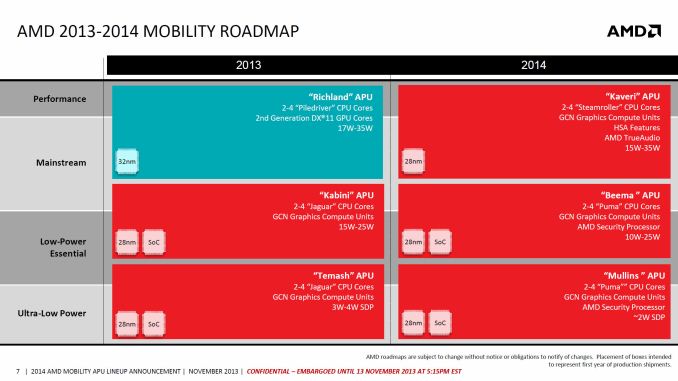
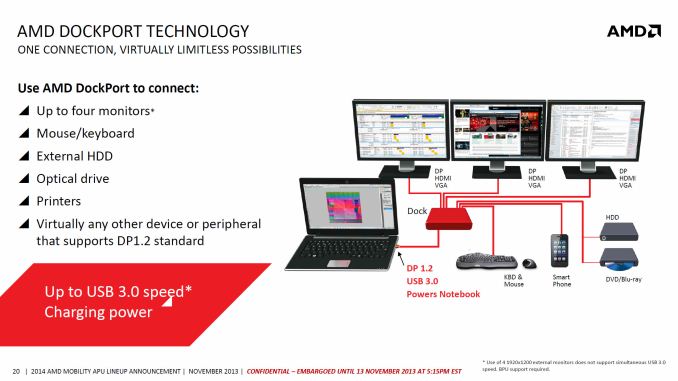
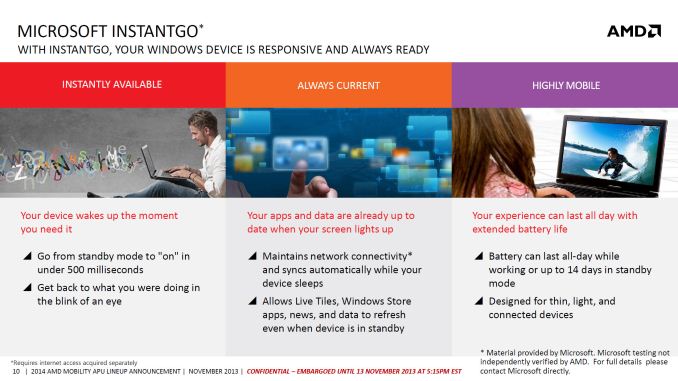
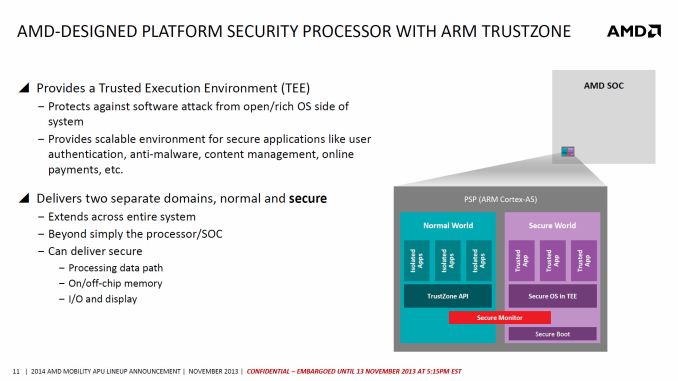














47 Comments
View All Comments
Drumsticks - Wednesday, November 13, 2013 - link
AMD really does have good designs limited by slow fab. The market would be a different place if Richland had been 22nm. Imagine how good this would be if AMD was preparing to launch 14nm parts in 2014 like Intel.Filiprino - Wednesday, November 13, 2013 - link
I'm sure that if AMD was on the same node as Intel, their processors would be a lot better, but Intel has the most advanced fabs on the world, even Samsung can't match Intel on high performance silicon.On the other hand, AMD has always been after Intel on fab nodes, but they could pull clever and efficient designs like the Athlon and Athlon 64. And now the company seems to be finishing the integration between AMD and ATI, a company they bought 7 years ago. Once all of their processes share a common base, the designs should improve big time, and we'll start to see that on 2014, expanding to 2017.
djscrew - Thursday, November 14, 2013 - link
I was just thinking that Intel shareholders must be content with basically just owning a Fab. The way the entire semiconductor industry is going, Intel is so far behind in everything except single core performance it is just bizarre (I love my OC'd i7 950 tyvm and plan to keep it for 3 more years until DDR4/etc...). Intel does have the best fabs but and despite the claims of silly TSMC and Sammy claims that they're catching up, it will still likely get harder for Intel to maintain their advantage with so much money pouring into the industry from the mobile boom. I predict that short some amazing design wins, we may see Intel turn into Fab. They could probably make more money being a Fab now anyways considering the idle capacity they undoubtedly have at 45, 32, and my guess is even at 22. Mantle is exciting innovation, so is the ARM x86 marriage in the form that it's in here. It all boils down to whether or not their movement to the process node before everyone else will continue to carry them. I suspect that it might, but not at the margins they have enjoyed in the past due to the difficulties of moving to smaller nodes and the bottom falling out of the PC industry. Microsoft failing so incredibly with 8 seriously damaged Intel's strategy.dylan522p - Thursday, November 14, 2013 - link
I want to know where else Intel is behind? They have the best chips from 2W to 150W. Atom is better than anything ARM makes and is slightly better than S800. Intel undoubtly owns the. Laptop desktop and server markets as well.ddriver - Thursday, November 14, 2013 - link
Really? The newest atom is only on par with current ARM chips and only in terms of CPU performance, while the GPU is much slower, and ARM V8 is just around the corner. And what is the market share of intel in tablets/phones?Anato - Thursday, November 14, 2013 - link
What are your criterions? Does it include market share or price?djscrew - Thursday, November 14, 2013 - link
Intel is so far behind in mobile market share it's not funny. Mobile is where the market has hurtled since '07 and the shift is showing no signs of slowing down. Go look up international smartphone growth vs. international PC growth over the past 3 years to see my point. (Also remember, I was referencing this from a shareholder's POV.) Desktop growth may return in a few years but it will be incremental at best. Microsoft, Intel's most critical partner, has failed enormously with Windows 8. The OS continues to experience lackluster sales and poor enterprise adoption. I work for a fortune 500 company and our IT department refuses to adopt Win 8 because it is far too different and awkward for users who were accustomed to the previous versions. Meanwhile, HTML5/JS based system agnostic productivity solutions (e.g. Google Drive, Lucidchart) continue to march forward and look more attractive to cost sensitive corporations. Longer PC update cycles, and a shift towards VDI as a replacement for expensive desktops invariably erodes support for one of Intel's highest earning markets. Granted, Intel might have some *potentially* promising architectures moving forward but so far Intel is being carried solely based on their process node lead. I question if Intel is spending aggressively enough on catching up in their architecture to rip away a significant segment of the Mobile market. Sure Intel is ahead in single core performance per watt, and will likely lead in that category for years, but it isn't as important as other categories. Most mobile apps do not necessarily require strong CPU cores to fulfill the majority of their use case. Intel is training behind in GPU, GPU compute and heterogeneous compute. Crystalwell was a big step in the right direction but IMHO, Intel needs to invest big time in catching up. On the other hand, their Fabs are top notch. Intel has 3D transistors, and will be the first to scale production at 14 nm. With the entire world coalescing around the flexible, open ARM based solutions, what is an x86 architecture to do? Finally, don't forget the very real threat of low cost, low power ARM based micro servers to Intel's server market share. Bottom line is if there isn't a remarkable turnaround in Intel's mobile fortunes, we will be seeing all of the architecture growth headed to Intel's giant, hungry army of competitors. That leaves Intel's best and nearly guaranteed growth prospects with their Fabs.medi02 - Wednesday, December 18, 2013 - link
You forget that ARM margins are laughable for Intel.Even if they had entire mobile market, it would be a joke income for them.
They are messing with it only because of ear, that mobile might eventually kill PC.
SetiroN - Thursday, November 14, 2013 - link
You just made a whole lot of nonsense.madgabz - Friday, November 15, 2013 - link
And You didn't?